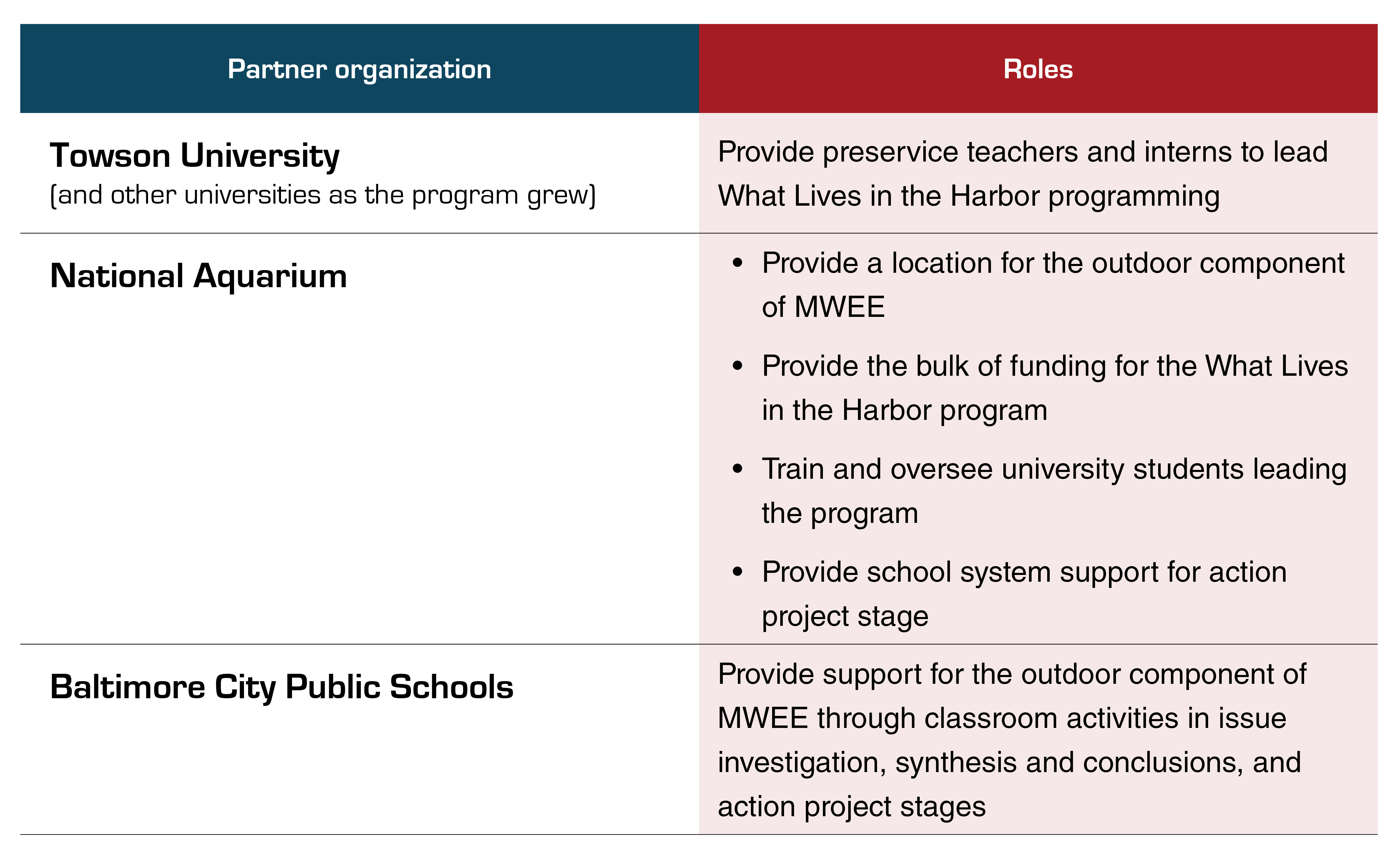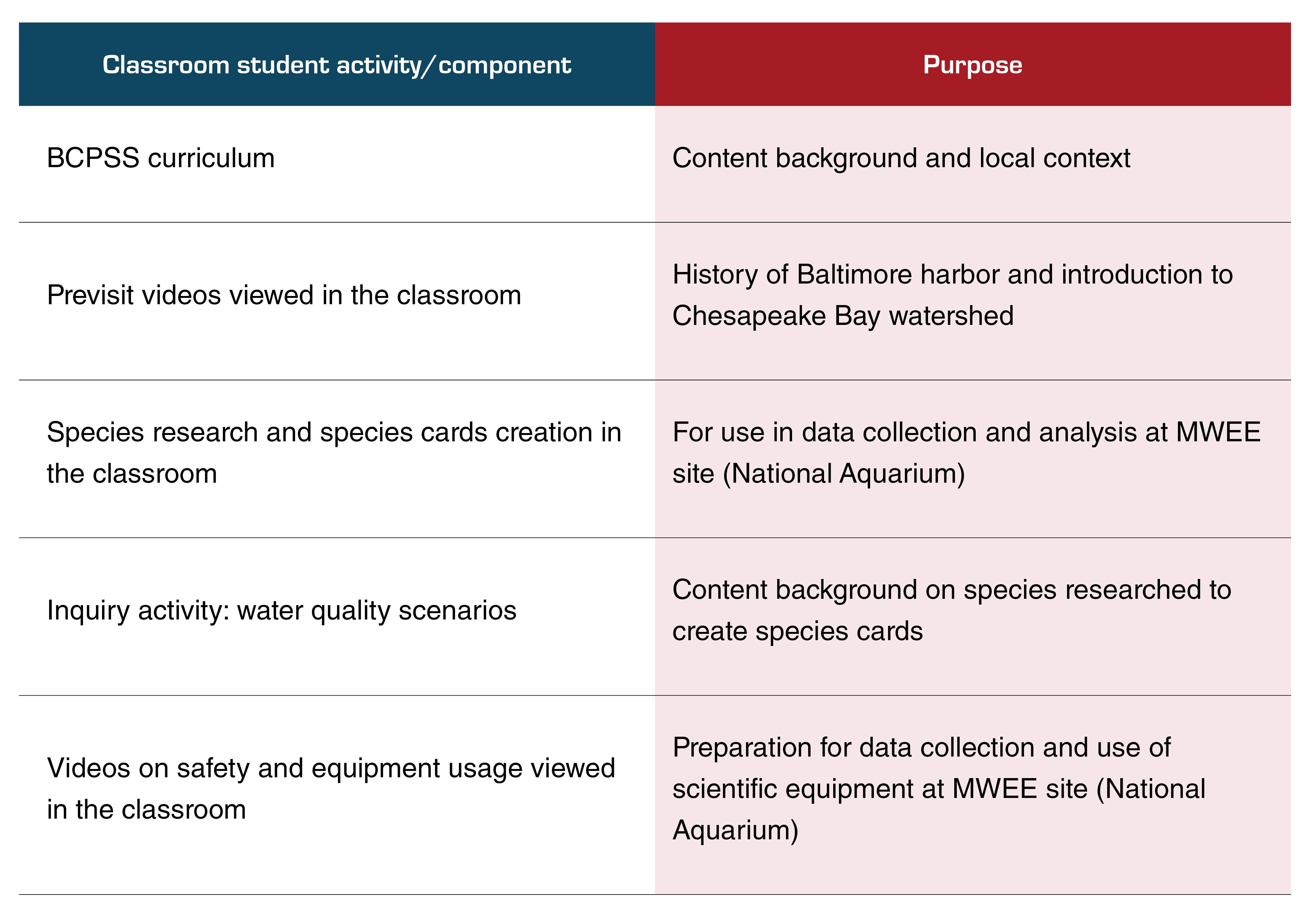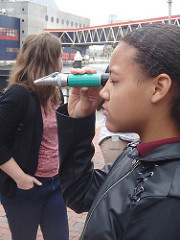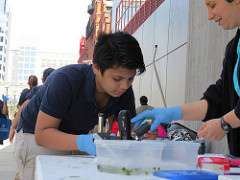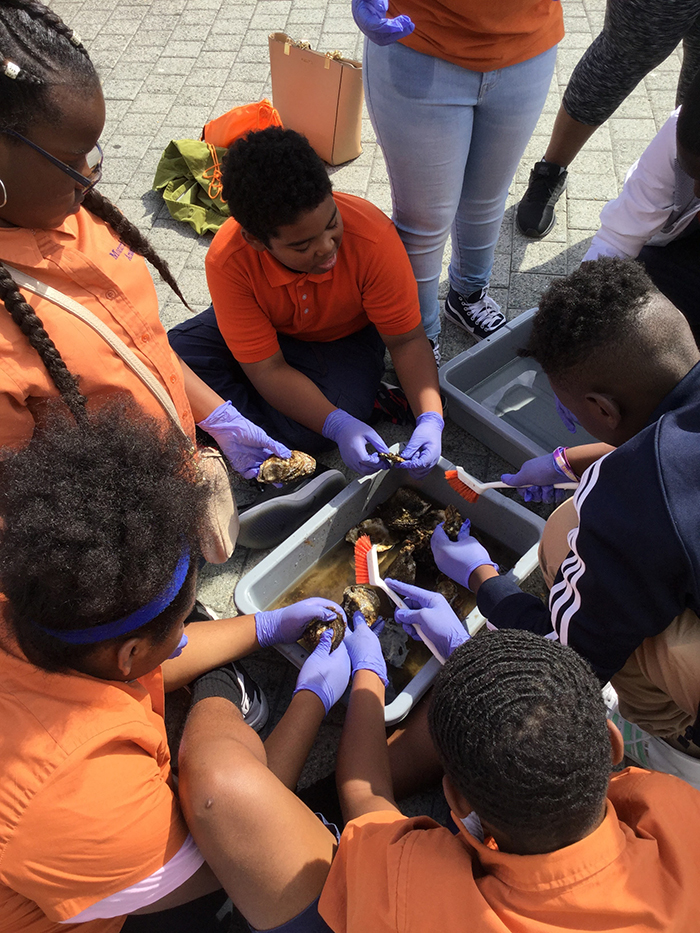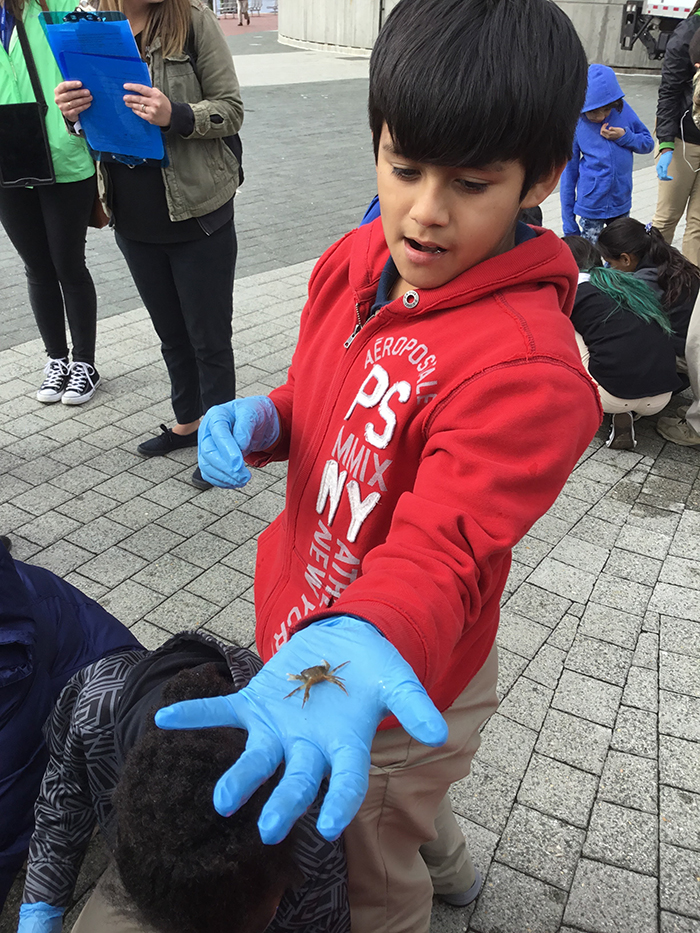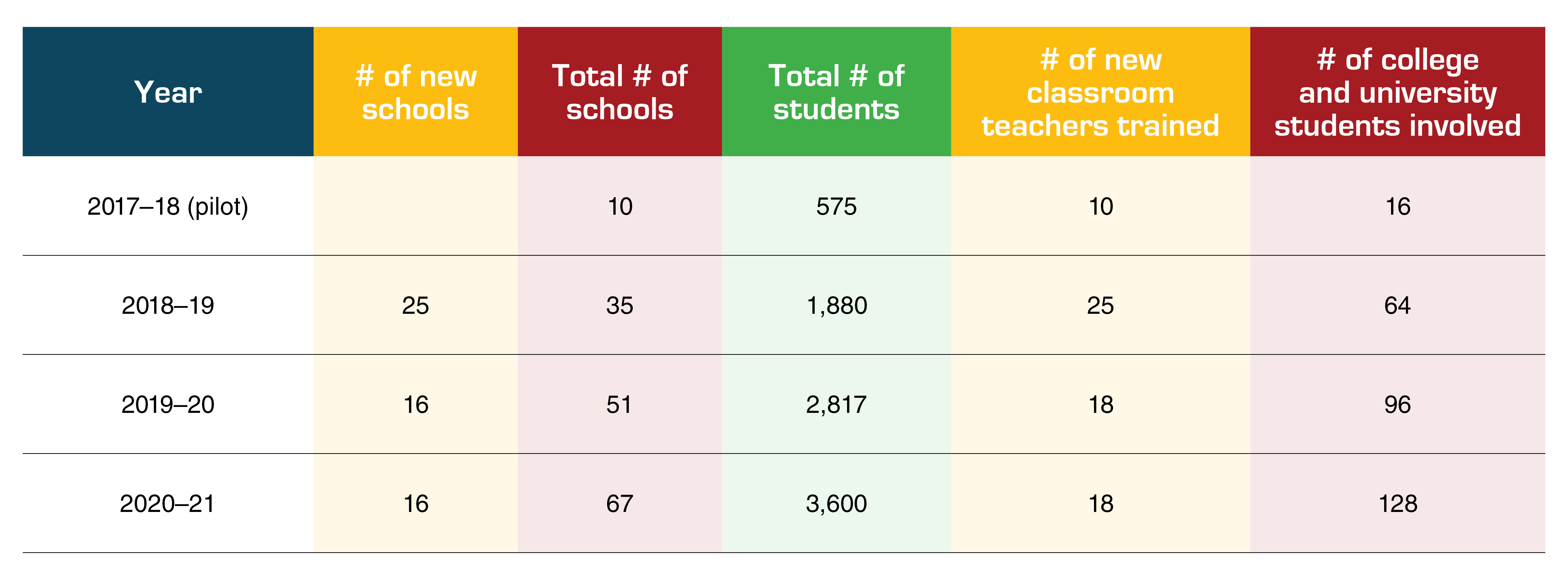Feature
Teaching Environmental Awareness in Baltimore
Providing Place-Based Watershed Education to Urban Middle School Students
Connected Science Learning July-September 2019 (Volume 1, Issue 11)
By Sarah Haines, Chelsea McClure, and Symone Johnson
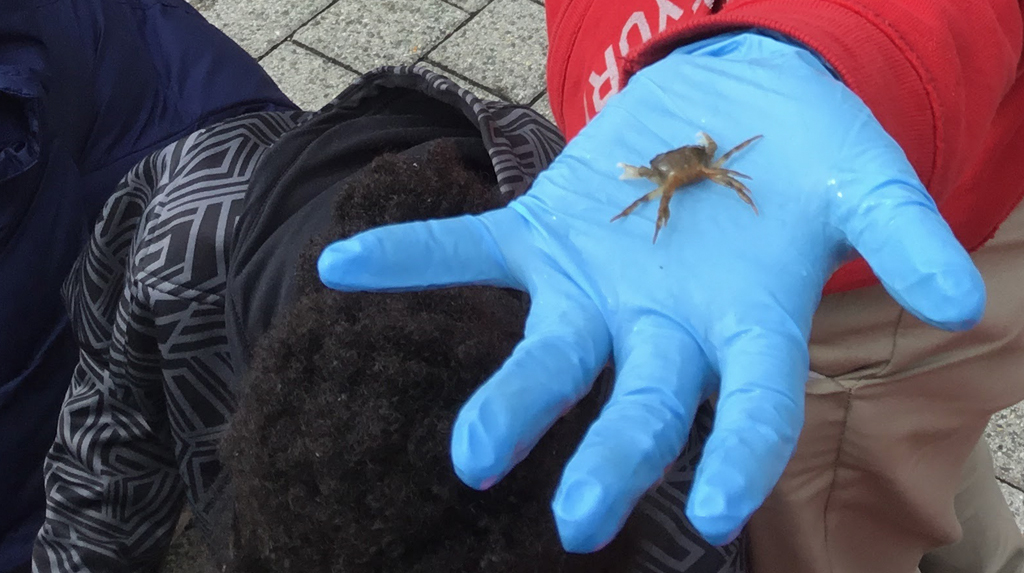
A national movement, sparked by Richard Louv’s (2005) treatise Last Child in the Woods, has catalyzed collaborations among government agencies, schools, and nonprofit and community organizations to reconnect children with the environment. Research has indicated the significant positive impacts of spending time in nature on children’s physical, cognitive, and social development (Coon et al. 2011; Rook 2013; Banay et al. 2015). This is especially critical at a time when the general public lacks a solid understanding of the importance and benefits of nature and its ecosystem services, or the many benefits that humans freely gain from the natural environment (Duvall and Zint 2007; Turnpenny, Russel, and Jordan 2014). Environmental education rooted in local, place-based issues is one way to ensure our youth have the knowledge and skills necessary to address complex socioscientific issues as adults. For example, Klosterman and Sadler (2010) found that the implementation of a place-based curriculum focusing on socioscientific issues surrounding climate change led to students expressing more detailed, accurate, and sophisticated understandings of global climate change and the controversies and challenges surrounding the issue. Furthermore, environmental literacy is a component of overall scientific literacy (Blumenstein and Saylan 2011) and requires the same skills, such as the ability to organize, analyze, and interpret quantitative data and scientific information) as other STEM (science, technology, engineering, and math) fields (Jordan et al. 2009). Recently, the following education requirements have been implemented in our state of Maryland to address the overlapping boundaries of human and environmental health:
- preK–12 environmental literacy standards, adopted by the Maryland State Department of Education (MSDE);
- a requirement that all public schools provide preK–12 students with place-based field experiences, called “meaningful watershed educational experiences” (MWEEs), that are focused on inquiry-based environmental education (Chesapeake Bay Program 2014); and
- a requirement that all incoming ninth-grade students complete a comprehensive, interdisciplinary environmental education program aligned with eight standards: environmental issues; interactions of Earth’s systems; flow of matter and energy; populations, communities, and ecosystems; humans and natural resources; environment and health; environment and society; and sustainability (MSDE 2019).
With these changes to preK–12 Maryland state education standards comes an increased need to support school districts and teachers in providing meaningful environmental experiences for all students. Likewise, there is a critical need to prepare preservice preK–12 teachers to meet MSDE’s environmental education standards upon entry into the profession. As a result, we created Teaching Environmental Awareness in Baltimore (TEAB), a partnership between a postsecondary institution (Towson University) an informal science education center (National Aquarium), and an urban public school system (Baltimore City Public Schools [BCPSS]). This partnership allows Towson University preservice teachers to deliver onsite at the aquarium environmental activities associated with a BCPSS MWEE called “What Lives in the Harbor,” which is designed for local middle school students. The experience supports preservice teachers in increasing their STEM content knowledge and developing their pedagogical skills for teaching environmental science. In addition, through this partnership, preservice teachers assist National Aquarium education specialists in expanding the aquarium’s urban education programs (see Table 1 for individual partner responsibilities).
Table 1
TEAB partners and roles
A major focus of TEAB is to engage middle school students in environmental issue investigations relevant to the local community that promote deep, critical thinking. TEAB has four interrelated civic goals:
- To engage urban youth who may have limited personal experiences with nature and/or a limited understanding of local natural resources;
- To assist preservice teachers in becoming confident, competent environmental educators through practical, hands-on professional development;
- To enact a place-based environmental curriculum that meets both the instructional guidelines of local school districts and state content standards; and
- To maximize environmental education through repeated interaction between K–12 students and educators.
We hope to address the following systemic problems through this project:
- the general need to increase the frequency of contact between children and nature,
- a disproportionate lack of exposure to nature for urban youth, and
- the need for well-trained teachers who can provide environmental education opportunities that foster children’s affinity for nature and stewardship ethic.
Program elements: What Lives in the Harbor and MWEE components
The What Lives in the Harbor program is designed to meet the Chesapeake Bay Watershed Agreement requirements for a MWEE. As put forth by the Chesapeake Bay Watershed Agreement, the MWEE structure consists of four essential elements (issue definition, outdoor field experiences, synthesis and conclusion activities, and action projects) that describe “what K–12 students [should] do,” no matter where the MWEE takes place or what the topic of the MWEE is. These elements promote a learner-centered approach that emphasizes the role of the student in actively constructing meaning from the educational experiences. Throughout the process students have time for reflection, allowing them to refocus on how what they are learning and experiencing affects the MWEE’s driving question. These four elements are described in the context of our program below.
Issue definition
In April 2013, the MSDE adopted new standards for teaching and learning in science, the Next Generation Science Standards (NGSS Lead States 2013), with the goal of increasing student proficiency in science. BCPSS is actively adapting its entire science curriculum and training its teachers to meet these standards. By partnering directly with BCPSS, the aquarium has developed a curriculum for the What Lives in the Harbor MWEE and ensured that it is embedded in the sixth-grade curriculum. MWEEs are learner-centered experiences that focus on investigations into local environmental issues and lead to informed action and civic engagement. Educators play important roles in presenting unbiased information and assisting students with their research and exploration. The MWEE correlates with the sixth-grade curriculum Investigating and Questioning Our World Through Science & Technology (IQWST) Learning Set 1: “Where have all the creatures gone?” as well as Learning Set 5: “Do abiotic factors affect populations?” What Lives in the Harbor is designed so that it may be taught out of sequence with the IQWST learning sets, if necessary, because the field experience to the aquarium cannot happen for all schools in the same two-week period when they are teaching the relevant learning sets.
In the case of our project, the driving question is, “What lives in the harbor?” BCPSS students are prepared for the field investigation through the IQWST curriculum described above, which spans two to four class periods and provides students with content background and context for the investigation that will take place at the aquarium. As a result of teacher feedback from spring 2017 programming, the aquarium created a set of previsit videos introducing the history of Baltimore’s Inner Harbor and the economic and ecological significance of the Chesapeake Bay. Also prior to the field experience, middle school students research species potentially living in the harbor and create a set of species cards with the typical living parameters for each animal. Students later use these cards as a resource during their field experience (see Appendix 1 for example student cards). Teachers also lead an activity in which their sixth graders determine how a scenario would affect the species they researched. Students end the issue definition phase by viewing videos about equipment use and safety information for the field experience. Teachers have reported that the videos provide their students with expectations for the day and build student confidence in completing the experience. Table 2 outlines the issue definition components of our MWEE.
Table 2
Issue definition components of the What Lives in the Harbor program
Outdoor field experiences
In our program, the outdoor field experience takes place on the piers of the National Aquarium. Drawing on their previsit activities, sixth graders begin their visit to the aquarium’s waterfront campus with a brief discussion about their local Baltimore harbor watershed and its role within the larger Chesapeake Bay. They then rotate through three stations, where they collect water quality readings. The aquarium uses Vernier equipment at the request of Baltimore City Public Schools, which is the same equipment used in city high schools. Each station is cotaught by two preservice teachers, and each group of sixth graders spends approximately 25 minutes at each station. At each station, middle school students collect quantitative data that help them determine which organisms on their organism cards would be able to survive in the harbor. All data are recorded on paper data sheets (see Appendix 2 for student handouts) and on portable electronic devices. The data are sent to classroom teachers for use in synthesis and conclusion activities that will subsequently take place in the classroom. The data can also be used to inform the chosen action project, described later in this article. The three stations are:
- Plankton and turbidity: Turbidity is defined and the consequences of low or high turbidity are discussed. Human impact on turbidity is emphasized. Turbidity is measured with a Secchi disk. The sixth graders assess phytoplankton living in the harbor using handheld microscopes and observe water color to determine species of phytoplankton present.
- Dissolved oxygen and salinity: Dissolved oxygen and salinity are measured with Vernier probes. Dissolved oxygen readings are taken both at the surface and closer to the harbor bottom. Human impact on these parameters is discussed, as well as what the measurements mean for the organisms living in the watershed.
- Temperature and pH: Temperature is measured with a digital thermometer and pH is measured using pH strips. Common household items (bleach, milk, orange juice) are used to help middle school students relate the pH scale.
To ensure their safety, all participants (preservice teachers, classroom teachers, aquarium staff, and middle school students) wear gloves during all of the activities. BCPSS students are kept back from the water’s edge, guided by a line delineated on the pier that they are instructed not to cross. All educators collecting water samples directly from the pier must be wearing a life jacket. BCPSS students obtain water samples from large buckets on the pier that the educators have collected. Life rings are available at several locations around the pier stations in case of an emergency water rescue.
Figure 3
BCPSS students measuring pH and temperature of harbor water
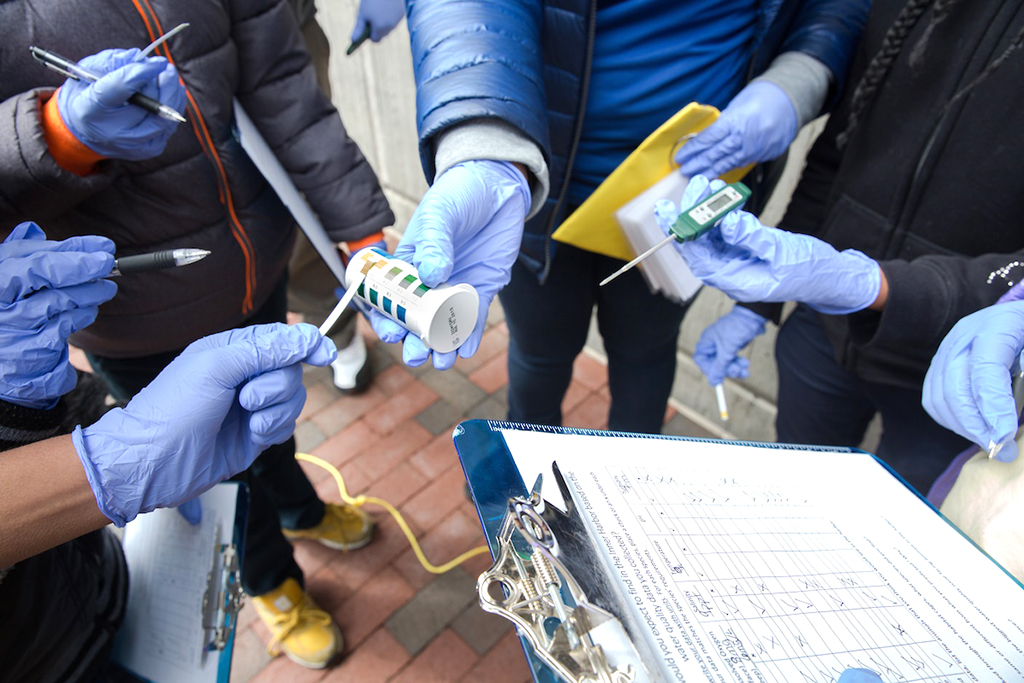
Synthesis and conclusion activities
Students use the data sent to their classroom teachers to determine which organisms would be able to live in the Baltimore harbor, and are asked to support their conclusions with evidence from the data collected. To support their hypotheses, BCPSS students use an iPad to survey and catalog what they find in habitat cages located at the pier. These data are also sent back to the classroom teacher for later use in lessons. Each group discusses its predictions, conclusions, and supporting evidence, using the claim-evidence-reasoning model. Students also discuss which water quality parameters seem to be the most important to biodiversity.
Action projects
The culminating component of the MWEE asks students to identify, explore, and implement solutions for action, based on conclusions and claims drawn through prior investigation. They then reflect on their chosen actions to determine the extent to which they addressed the identified problem or challenge. They may also share proposals for sustaining or extending their actions.
In our case, following their outdoor experience, sixth graders identify one water quality parameter that is negatively affecting organisms in the harbor, and then work in groups to brainstorm issues in their neighborhood that could impact water quality and aquatic species. They select one issue and suggest an action they or others in their neighborhood could take to positively change these issues. From this exercise, schools conduct several different action projects, including:
- designing a small garden to be built on the school’s property during the next school year,
- creating posters to promote improving water quality and reducing waste,
- writing letters to the principal and elected officials about the importance of the bay, and
- pledging to reduce, reuse, and recycle 10% more over summer break.
Additionally, to help inspire student action projects while students are still at the aquarium engaging in the outdoor component of the MWEE, preservice teachers assist them in participating in an ongoing action project at the aquarium. Preservice teachers guide the sixth graders in taking inventory of living spat (oyster larvae attached to adult oyster shells). These data are provided to the aquarium’s field conservation department and contribute to one of the aquarium’s broad conservation goals. At the end of each school year, the spat will be added to the aquarium’s recently created oyster reef, which provides a unique habitat to the urban wildlife of the Baltimore harbor.
Program outcomes
Impact on preservice teachers
Our desired outcomes for preservice teachers are that they will:
- Deepen their understanding of how environmental factors (e.g., dissolved oxygen, temperature, salinity, turbidity) affect aquatic life in the Inner Harbor.
- Deepen their knowledge and understanding of environmental science topics through exposure to content while delivering aquarium programs.
- Feel confident teaching environmental education topics in informal settings.
- Demonstrate increased personal interest in aquatic environmental issues affecting their local community.
- Appreciate that aquatic environmental issues affect their everyday lives.
- Strengthen pedagogical skills (e.g., issue investigation, outdoor teaching techniques, safety considerations) through delivering a MWEE for middle level students.
- Strengthen pedagogical content knowledge in delivering science lessons.
Average scores on two content-based quizzes given to the preservice teachers as part of their course completion requirements were 92% and 99%, respectively. Preservice teacher scores on their written lesson plans that they are required to write for each weekly experience improved over the course of the semester as well (class averages of 87% and 98%, for the first and last lesson plans). These data show that preservice teachers made learning gains in the area of content knowledge and pedagogy.
Attitude and interest outcomes were measured through weekly reflections assigned to the preservice teachers as part of their course grades. Overall, preservice teachers became more interested in science, and watershed issues in particular, as a result of participating in this course. A few of their comments:
- “This class has allowed me to enjoy science more personally and have even more of a desire to potentially become a science teacher.”
- “I am much more interested in marine science.”
- “I thought that this experience would be a lot of work. It was a lot of work but it was information that I found interesting.”
- “Really helped me care more for the aquatic environment and ecosystem as a whole.”
Skills outcomes were measured through written lesson plan assignments, weekly reflections, and teaching observations. In reflections, we found that, again, preservice teachers felt that they had gained skills that would help them be more effective teachers in the classroom. It was evident through their written lesson planning and teaching observations that their delivery methods improved over the course of the semester. Participating preservice teachers also reported feeling more confident in teaching science content:
- “I think I gained a lot more confidence in my ability to teach content. I have also learned to be flexible when things don’t go the way I want them to.”
- “How to work with others and how to effectively write a 5E lesson plan. Also, analyzing other lesson plans and changing them into 5E format.”
- “I am much more confident in speaking in front of other adults and engaging with families. I learned how to properly write a science lesson and in what fashion it should be taught. I learned how to adapt better to change”
- “Really helped me with my first coteaching experience. Also helped me to adapt to teaching in different environments.”
Impact on National Aquarium
The involvement of Towson University preservice students in delivering the What Lives in the Harbor programming allowed the National Aquarium to serve BCPSS students without straining the aquarium education department’s limited staff. Because the partnership with Towson University was such a successful model, aquarium staff have reached out to other local colleges and universities to put similar partnerships in place; the National Aquarium has developed a staffing model currently using interns from five local universities. Towson University and Morgan State University are both using the partnership with the National Aquarium to provide an experiential learning opportunity for preservice teachers as a part of specific courses for university students who are pursuing education degrees. The other three universities are using the partnership to provide university students with internship credit.
At full implementation in the 2020–2021 school year, the aquarium will have 128 interns from local colleges and universities who will provide on-site instruction for middle school students during their field experience. Each partnering college or university will contribute one day per week of programming at the aquarium in the fall and/or spring semester(s), leading instruction with four to eight schools each semester. Thirteen university students served as interns on six Wednesdays and five Thursdays in fall 2018. An additional set of 21 university students served as interns during the spring 2019 semester.
Impact on BCPSS
We observed many benefits to BCPSS middle school students who interacted with the Towson preservice teachers during the outdoor experiences at the aquarium. The most important benefit was that the addition of preservice teachers allowed for smaller group work than would have been possible if only Aquarium educators were involved. Because of the smaller group sizes, BCPSS students received more personalized instruction and had more opportunities to engage.
Data collected by the external evaluator (pre-/postcontent surveys) indicate that the middle school students’ knowledge increased in areas focused on watershed concepts after participation in the program. BCPSS students also tended to demonstrate a greater desire to improve the watershed after completing the program and learning about human impact on water quality.
The program will have an even greater impact on BCPSS in the coming years, as the National Aquarium plans to grow the What Lives in the Harbor program to reach full scale by 2021, systematically adding 16 to 25 schools per year. Once fully implemented, What Lives in the Harbor will annually serve approximately 3,600 students and 71 teachers from 67 schools within BCPSS. See Table 3 for an overview of the impact of the What Lives in the Harbor program on all partners.
Table 3
The aquarium’s tiered approach for systemic implementation by 2021
Conclusions
Environmental education should be a continuous process throughout K–12 education, creating opportunities for individuals to develop an awareness of their environment and to gain knowledge, values, skills, and experiences necessary for solving environmental problems (Vaughan et al. 2003). It is important to continue to develop both student and teacher awareness, knowledge, values, skills, and experiences over time. Our partnership helps address these goals by providing curriculum-embedded STEM experiences that are aligned to grade-level science curricula, and promoting conservation of natural resources through addressing impacts on the Chesapeake Bay.
We consider the What Lives in the Harbor partnership program a success due to our achievement of the following goals:
- University students met the four TEAB civic goals set forth for the project.
- Positive responses from university students on their environmental education experience.
- Effective collaboration between preservice teachers, faculty, and aquarium staff to deliver quality watershed education programs to BCPSS students.
- Continued support for the What Lives in the Harbor program. This support is allowing us to increase BCPSS student participation from 575 students in 2017 to 3,600 students by the year 2021.
Recommendations for others
Here we list some recommendations we have for other organizations considering a similar project or program.
Consider your local context
How connected students are to where they live affects how they learn. Therefore, a basis of environmental education is understanding and forging a connection with students’ local community (Bodzin, Klein, and Weaver 2010). Using place-based education is essential in developing generations of citizens who are environmentally literate stewards. What Lives in the Harbor focuses on the connection our students have with the Chesapeake Bay. However, all of us live in a watershed and thus meaningful watershed education experiences are relevant to all students. What watershed do you live in? What local watershed issues can your students investigate?
Every community has environmental issues that are of local context and importance, whether watershed-based or not. Consideration of these issues is imperative when building partnerships and place-based environmental education experiences. It will make investigations more authentic and meaningful for students.
Make sure stakeholders are aware of the value of your project
Lack of awareness of the educational value of partnerships or of local environmental issues is a potential challenge. In our case, we found a large support system through the National Aquarium, the universities, and BCPSS. It is important to educate teachers and potential partnership leaders on the benefits and importance of environmental literacy, programs that are place-based, and community engagement. If all stakeholders are involved—teachers, informal educators, administrators, community leaders—and sending students the same message, learning experiences will be more meaningful because students will be better able to make connections to their local communities.
Securing partners and funding
Once you have a local issue in mind, the next steps are to identify partners and find funding for your project. Funders will usually want to see that all partners are committed to collaborating and have the capacity to see the project through. Find organizations whose mission and vision closely match with the local environmental issue of interest. Often, informal education institutions offer programming at local schools. Although we had students travel to the National Aquarium, it may be possible for you to have your outdoor field experience occur directly on school grounds.
Carefully consider each part of your project that would require funding. For example, here is a short list of common budget items for MWEEs that would likely transfer to other projects:
- Buses: This is by far the largest expense for our project!
- Substitute teachers: Will you need class coverage while teachers are participating in professional development or taking some students on field trips?
- Staff: Part of our budget is used for the salary of a dedicated program coordinator at the National Aquarium. Are there other staff that you would need to hire?
- Equipment and supplies: For our project, we purchased water quality testing equipment.
- Transportation costs for university faculty and preservice teachers: We cover the cost of travel to and from the aquarium each week
It is important to consider whether you will need to recruit any volunteers to implement your project, as this is another type of resource investment. For example, would parent chaperones be helpful? Could you enlist the assistance of college or university students? Creating connections to local universities might be a viable way for you to broaden your impact and strengthen your ties to the local community. Perhaps faculty at your local university have expertise in your environmental issue.
Sarah Haines (shaines@towson.edu) is a professor of biology and science education at Towson University in Towson, Maryland. Chelsea McClure (cmcclu4@students.towson.edu) is a graduate student in the Department of Biological Sciences at Towson University in Towson, Maryland. Symone Johnson (SyJohnson@aqua.org) is the Urban Conservation Education Program lead at the National Aquarium in Baltimore, Maryland.
Citizen Science Environmental Science Teacher Preparation Middle School Informal Education



